|
|
|||||||||
|
|
|||||||||
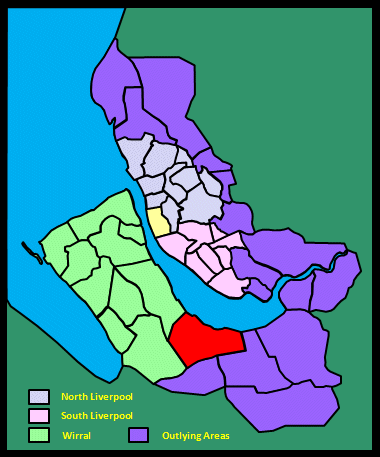 |
| CLICK A BOOTPRINT FOR A RELEVANT WALK - LINKS TO OTHER SITES AT THE BOTTOM OF THE PAGE |
| Great Sutton in Lewis's Topographical Dictionary of England (1848) The township comprises an area of 1050 acres, whose prevailing soil is clay; and contains a few farmhouses and other ordinary buildings, scattered on the side of the road between Chester and the ferries on the Mersey. The Chester and Birkenhead railway has a station in the vicinity. |
||
| Little Sutton in Lewis's Topographical Dictionary of England (1848) The township comprises 1108 acres, the soil of which is partly loam and partly clay. The road from Chester to Birkenhead runs through, and the Chester and Birkenhead railway has a station in the vicinity. The village is formed of a group of ordinary farmhouses: the principal part of its former little trade was derived from the stage-coaches which passed through it, before the establishment of the railway. |
||
| Great Stanney in Lewis's Topographical Dictionary of England (1848) This liberty, which belonged to the adjacent abbey of Stanlow, comprises 947 acres of excellent arable and meadow land, in which is found marl of very good quality, composed of alluvial matter: large trees have been dug up in the meadows. The ancient mansion here of the family of Bunbury, called Rake Hall [now a pub], has been repaired by its present owner, Sir Henry Bunbury. |
||
| Ellesmere Port in Lewis's Topographical Dictionary of England (1848) A small town or port [...]. This place owes its origin to the formation of a canal from Chester to the river Mersey here; though for some years after the opening of the navigation, the progress of the port was slow. At present, there are about 200 houses, many of them of neat aspect; a fine range of warehouses, erected on arches, with branches of the canal passing below; and a splendid floating-dock, containing upwards of 60,000 yards of water-space. A large dock, also, for coasters, was opened in September 1843; and other works have been formed, connected with boats and shipping. The canal itself was commenced towards the close of the last century. |
||
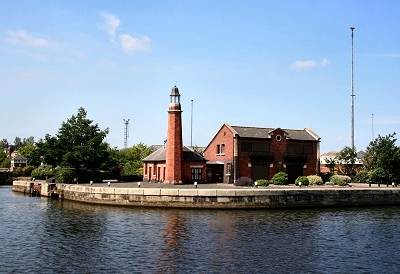 |
Ellesmere Port Lighthouse Thomas Telford's Ellesmere Port Lighthouse, also known as Whitby Lighthouse, is located at Whitby Locks on the Manchester Ship Canal at the entrance to the Shropshire Union Canal. Its main function was to guide boats into the Shropshire Union Railway and Canal dock complex (now the site of Ellesmere Port Boat Museum) from the River Mersey at Pool Hall Docks. The present 36 ft (11 m) lighthouse was built in 1874 by the London and North Western Railway Company who were improving the area. It operated successfully until the Manchester Ship Canal, which opened in 1894, reached Ellesmere Port and cut off the direct access to the Mersey, thus rendering it redundant. It is the only lighthouse on the British inland waterways system. The lighthouse and Harbour Master's office have been restored and are now listed buildings situated adjacent to the Boat Museum's lower basin. |
|
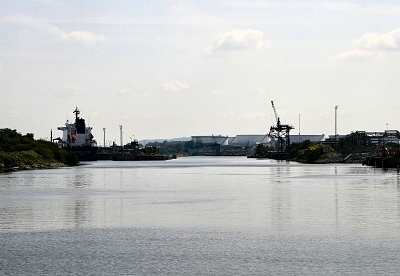 |
The Manchester Ship Canal near Stanlow Construction of the Manchester Ship Canal's 36 mile (58 km) length was divided into eight sections, with an engineer responsible for each. The first section was from Eastham to Ellesmere Port. Mount Manisty, a huge mound of earth northwest of Ellesmere Port on a narrow stretch of land between the canal and the Mersey (named after the engineer for that section), was created from the soil extracted by the excavations in that area. The ship canal was completely filled with water in 1893 and opened to its first traffic on 1 January 1894. Queen Victoria performed the official opening later that year. The ship canal had taken six years to complete at a cost of just over £15 million. It was the longest river navigation canal in the world and remains the world's eighth-longest ship canal, only slightly shorter than the Panama Canal. An average of 12,000 workers were employed during construction, peaking at 17,000. The scheme called upon over 200 miles (320 km) of temporary rail track, 180 locomotives, more than 6000 trucks and wagons, 124 steam-powered cranes, 192 other steam engines, and 97 steam excavators. The Manchester Ship Canal enabled the Port of Manchester to become Britain's third busiest port, despite being about 40 miles (64 km) inland. |
|
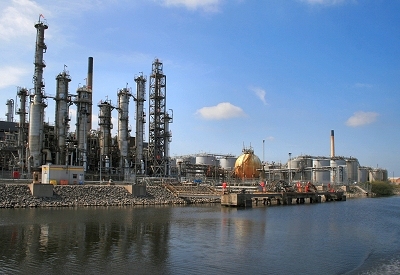 |
Petrochemicals Plant at Stanlow The Manchester Ship Canal passes this small section of the huge petrochemicals plant known as Stanlow Manufacturing Complex. The refinery was bought by the Indian conglomerate Essar Energy from Royal Dutch Shell in 2011. The complex occupies nearly 1,900 acres (3 square miles or 770 ha) and dates from 1924, when a small bitumen plant was established. In the 1970s an oil pipeline was constructed from Amlwch in Anglesey (North Wales). Crude oil was pumped ashore from tankers moored at deep-water pontoons. The pipeline closed in the early 1980s. Crude oil is now received lower down river on the Mersey at the Tranmere Oil Terminal, operated by the Mersey Docks and Harbour Board, and is transferred via a fifteen mile (24 km) pipeline to storage at Stanlow. |
|
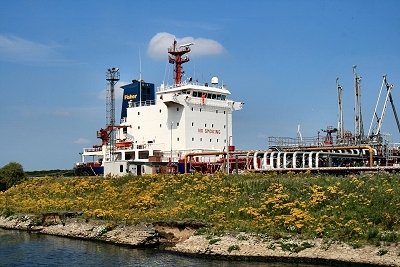 |
Stanlow Oil Dock The first oil dock was built at Stanlow in 1916-1922, ready for Royal Dutch Shell to begin their bitumen operations nearby in 1924. A second dock followed in 1933 and further expansion began in 1949. |
|
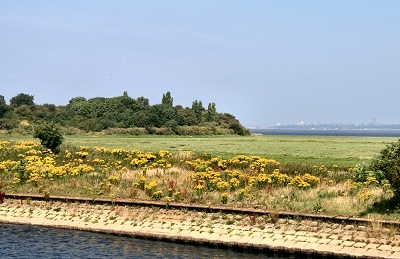 |
Stanlow Point Stanlow Point, next to the outlet of the River Gowy into the Mersey and completely isolated by the Manchester Ship Canal, is the location of the historically important Stanlow (or Stanlaw) Abbey, now allegedly scant ruins. Aerial photography shows a small rocky outcrop at the tip of the point that looks as if it served as a mooring. The abbey was founded in 1178 by John FitzRichard, the sixth Baron of Halton. The exposed situation lead to it sufferering from a series of disasters. In 1279 it was flooded by water from the Mersey and in 1287 during a fierce storm, the tower collapsed and part of the abbey was destroyed by fire. The monks appealed to the pope for the monastery to be moved to a better site and, with the pope's consent and the agreement of Edward I and Henry de Lacy, the 10th Baron, they moved to Whalley Abbey near Clitheroe, Lancashire, in 1296. A small cell of monks remained on the site until the Reformation. The standing remains include two sandstone walls and a doorway, incorporated into the remains of a later farm, and the buried features include part of a drain leading to the River Gowy, surviving as a tunnel lined with four courses of sandstone blocks. Apparently Stanlow Point is classified as a bonded site, outside of the UK for customs purposes and seriously out of bounds to mere mortals. |
|